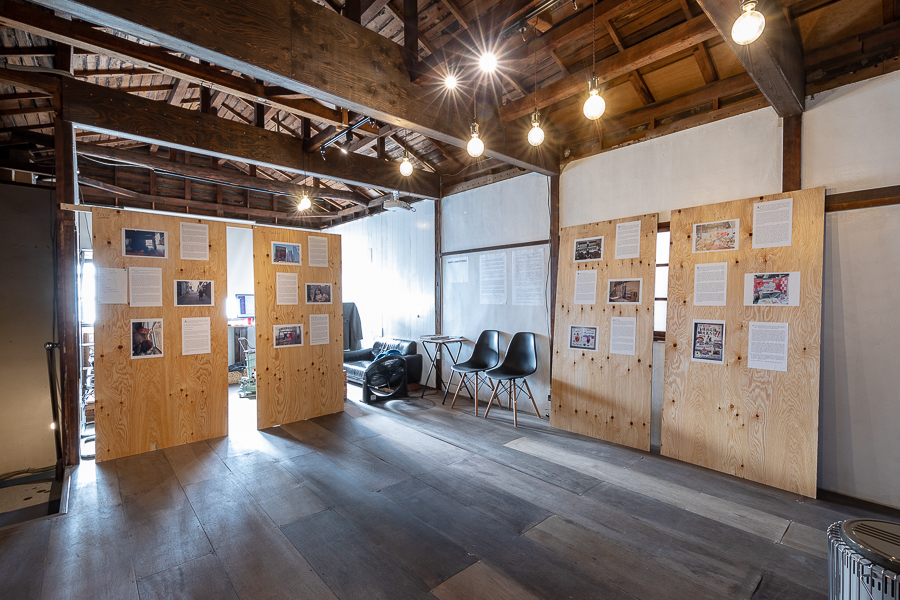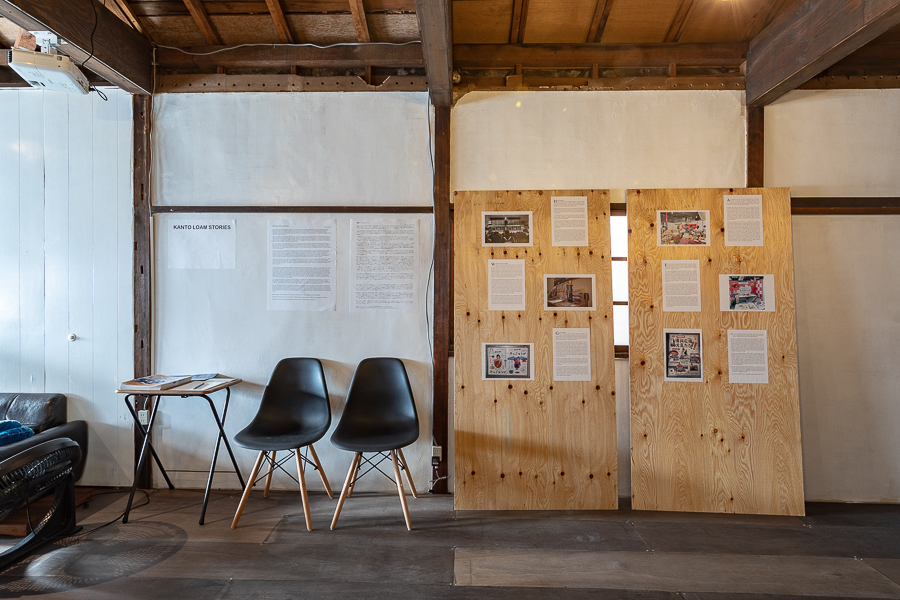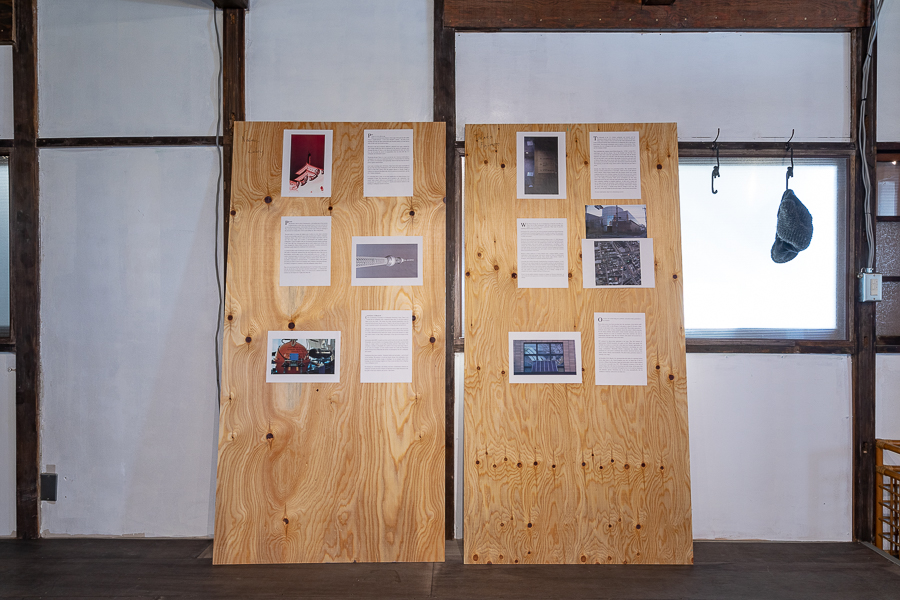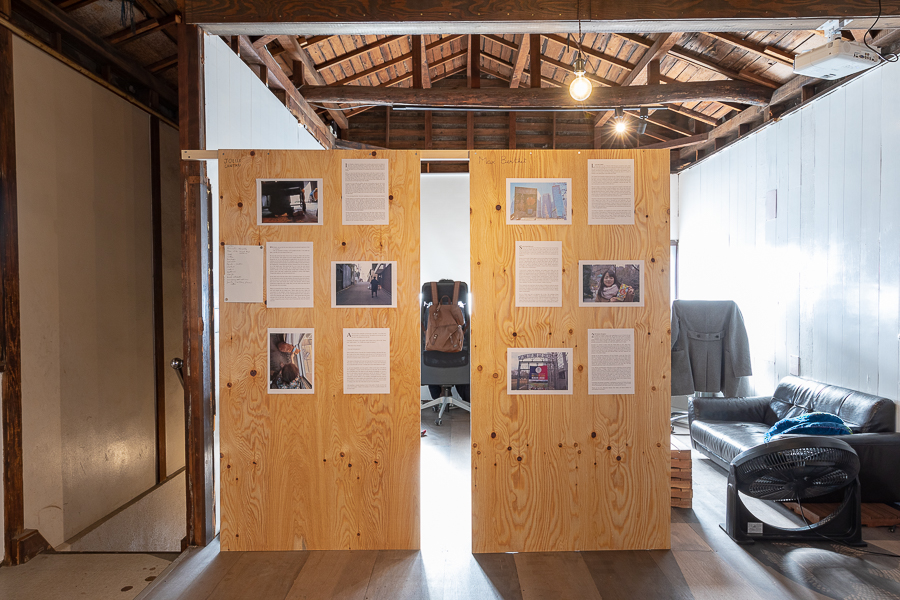インスタレーションビュー撮影:松尾宇人
関東ロームストーリーズ
会期:1月15日(火)〜1月25日(金)(休みなし)
時間:14:00 〜 19:00
場所:NOT SO BAD(〒112-0002 東京都文京区小石川4丁目-16-6-2F)
関東平野には、富士山などの火山灰が堆積した関東ローム層が広がっています。私たちはかつての災害の痕跡の上で生活を築き上げ、昔話の中の事柄として記憶を形成しています。2011もかつての災害の記憶の中に組み込まれていくのでしょうか。放射能の降灰は関東の地層にすでに溶け込んだ過去の物語りなのでしょうか。関東ロームストーリーズは、関東地方から地理的/時間的に離れている(ように感じる)震災に視点を持つ展覧会です。
ユミソン
2011年3月11日の東日本大震災とそれに続く津波とメルトダウン以来、福島と三陸沿岸に住む日本人がどのように震災に影響を受け、また影響を受け続けているかについて多くの逸話があった。かたや東京では、多くの人々の生活が数年で戻り、復興や修復に関する一般知識は震災当時のままに、 2011年3月の出来事とその余波は、昔、遠く離れた地域で起こったこととして、遠い記憶になったようだ。
だが、それは事実か?今日東京以外の場で、2011の余震と降灰を読み解くにはどうすれば良いのか。この展覧会は、民間および公共主導による被災地と東北地方の災害の復興をめざす/東京と近郊の住民/企業/大学/政府機関/が、幾重にも重なる災害の影響を受け続けるさまをフォトエッセイで検討している。また直接関与や影響を受けていない人々、特に東京の若い日本人学生および留学生がどのように反応するのかも検討対象である。
この展覧会はどのようにして生まれたのか?私はこの1年間、東京大学文化資源学科で「Short-Form Art Writing(短編アートライティング)」という大学院課程の教鞭を執った。秋と冬学期の授業のテーマは「Art and Disaster(芸術と災害)」、特に2011年3月とその余波に焦点を当てた。芸術専攻の学生や日本の学生は少なく、留学生にとって2011年の災害とそれに対するアーティストの反応について理解することは厳しく、本展と作品は、詳細な情報と批評的な反応を学ぶような展示となった。
英文による芸術批評誌のレビューの読み解き通し、芸術を調査した後、我々はいつくかのケーススタディを研究した。アーティストの加藤翼と瀬尾夏美は、私たちの授業で被災地での彼らの作品について丁寧に語った。残念ながら授業は東京なので、私たちは気仙沼のリアスアーク美術館と福島のChim↑Pomの“ Don’t Follow the wind”プロジェクトについては、画像とテキストを通して、震災後の展示でのみ考えるしかなかった。しかし、私たちは森美術館「カタストロフと美術の力」展と、(歴史的展望を得るために)両国近くの横見町公園にある1923年の地震と1944 年から45年の東京空襲で亡くなった人々のための関東大震災記念館と伊藤忠田記念館を訪れた。
生徒たちにはほぼ毎週Instagramの投稿(最大2200文字)を以って、授業に参加するように求めた。その中で、死と生死、災害と復興、そして芸術の社会的価値と政治について学んだ。非公開の投稿もあるがインスタグラムのハッシュタグ#tantanpen から彼らの投稿が閲覧できる。タンタンペンとは、文字通り「ショートショート形式」だが、「短編」(タンペン)と辛い四川風麺で知られる担々麺(タンタンメン)にもかけた言葉遊びだ。
彼らの文化/芸術的努力の評価と判断をし、3か月後に生徒たちの最終的なプロジェクトに、彼ら自身で何かを創造するのは妥当と考え、フォトエッセイとして本展を開催した。授業の大部分は2016年(震災から5年)以前を扱っているので、現在何が起こっているのかを学ぶことは不可欠だった。リアス・アーク美術館のキュレーター山内宏泰による事実と記憶を織り交ぜた口語による記録を元にした優れた物語り表現、そして瀬尾夏美(NOOK)とせんだいメディアテークの語りのプロジェクトの組み合わせに触発され、私は彼らに短いフォトエッセイ(写真3枚とインスタグラム長のテキスト3枚)での応答を求めた。2011年の痕跡を現在の東京でどう読むのか?東北への旅は時間と予算が必要となるので、生徒たちにとって利便性の高い東京地方を中心とするよう依頼した。通常の衝迫は、東京中心主義を批判し、被災地がどのように管理されているかを確認するため北に向かうので、この依頼は意図的であるが、生徒たちの直感に反する。
しかし驚いたことに、彼らは適切なストーリーをすぐさま見つけ出した。それ自体が教示的だ。彼らの展示の基盤となるのは、スポーツイベント/再生可能エレルギー/何を食べ/どこに旅行し/都市の地平、簡単に言えば近隣の移動や身の回りの品についてどのように考えているのか/を観察しているということだ。 2011の余塵は、今日の東京の仕事、レジャー、そして日常生活、まさにその一部である。彼らのプロジェクトはまた、2011とは思い出を解く鍵にとどまらないことを示す。 2011は現存し、進化する出来事である。
今、あなたは生徒たちの見解に同意しないかもしれない。彼らがあまりにも/大雑把で/批判的で/ポエティックで/朴訥で/情報が少ない/と思うかもしれない。確かに、私自身を含め、私たちはより調査を行うことで功を奏せる。しかしこのプロジェクトのポイントは、第一義に自分自身で動くことである。なぜならある問題に関心を持てるのは一度だけであり、その主張は一般の人々に意見を公開することに他ならならず、気づきの過程は責任と持続性にあると私は信じているからだ。私は無知だということも含め、多くのことを学んだ。教師は生徒が学ぶよりも生徒から学ぶことが多いとよく耳にする。私は、それが確かに事実であると誇りを持って言える。
ライアン・ホームバーグ(東京大学文化資源学科)
参加者:Max Berthet, Joelle Chaftari, Hidaka Mari, Noemie Lobry, Fujimoto Takako, and Vanessa Yang.
Kanto Loam Stories: An Introduction
by Ryan Holmberg
Since the Great East Japan Earthquake of March 11, 2011, and the tsunami and meltdowns that followed in its wake, there have been many moving stories about how the disaster impacted, and continues to impact, Japanese living in Fukushima and the Sanriku Coast. Meanwhile, in Tokyo, life returned to normal for the vast majority of the population within a few years. General knowledge about the remediation and reconstruction efforts is sorely out of date. March 2011 and its aftermath seems like a distant memory, something that happened a long time ago in a region far, far away.
But are they really? How can one read the aftershocks and fallout of 2011 not in the Tokyo area today? That is the question this exhibition aims to address, through photo-essays looking at the way residents, businesses, universities, and government agencies in and around Tokyo continue to be influenced by the triple disaster and the private and public initiatives aimed at rehabilitating the disaster zones and the greater Tohoku region.
How did this show come about? Over the past year, I have been teaching a graduate course titled “Short-Form Art Writing” in the Cultural Resources Studies Department at the University of Tokyo. During the Fall/Winter semester, the theme of the class was “Art and Disaster,” focusing specifically on March 2011 and its aftermath. As few of the students were art-related majors, and even fewer were Japanese, the course became as much a tutorial about the 2011 disaster and how artists have responded to it, as it was about the practice of crafting tight, informed, and critical responses to artwork and exhibitions.
After surveying such art through the lens of magazine reviews, we studied a handful of specific case studies. Artists Katō Tsubasa and Seo Natsumi were kind enough to visit our class to talk about their work in the disaster areas. Unfortunately, bound to Tokyo, we could only consider the post-tsunami exhibit at Rias Ark Museum in Kesennuma and Chim↑Pom’s “Don’t Follow the Wind” project in Fukushima second-hand through images and text. But we did have the opportunity to visit the exhibition “Catastrophe and the Power of Art” at the Mori Art Museum and (to gain historical perspective) the Great Kanto Earthquake Memorial Museum and Itō Chūta’s Memorial Hall at Yokoami-chō Park near Ryōgoku, dedicated to those who died in the 1923 earthquake and the Tokyo Air Raids of 1944-45.
Approximately every other week, students were asked to respond to class sessions by composing Instagram posts (2200 characters max), in which they reflected on life and death, disaster and reconstruction, as well as the social value and politics of art. While not all of their accounts are public, most of the course’s output, as well as my assignment guidelines, can be found under the hashtag #tantanpen – which literally means “short-short-form,” but is a portmanteau of the Japanese for “short-form writing” (tanpen)and the spicy Sichuanese noodles known as tantanmen.
After three months spent appreciating and judging other peoples’ curatorial and artistic endeavours, I thought that it was only fair that they create something themselves for their final project. The result is the photo-essays in the present exhibition. Moreover, as most of what we looked at in class was made prior to 2016 (the fifth anniversary of the disaster), I thought it imperative that we learn about what is happening now. Inspired by the unique narrative presentation at the Rias Ark Museum, which mixes factual description with imagined oral recollections, and the storytelling projects carried out by Seo Natsumi, NOOK, and the Sendai Mediatheque, I asked my students to create a short photo-essay (three photographs and three Instagam-length texts) addressing the question: How can one read the legacy of 2011 in Tokyo today? Asking them to focus on the Tokyo region was of course motivated by convenience, since travelling to Tohoku requires time and money. But it was also intentionally counterintuitive, since the usual impulse is to decry Tokyo-centrism and head north to see how the disaster zones are managing.
Much to my surprise, they had no problem finding relevant stories. As their projects demonstrate, whether in the form of sporting events, solar power initiatives, Tohoku tourism campaigns, promotion of regional food brands, advances in seismographic research and engineering, or simply how people navigate their neighbourhood streets or care for their cat, the aftereffects of 2011 are part of the fabric of work, leisure, and daily life in present-day Tokyo. What their projects also show is that 2011 is hardly a cipher of memory alone. Quite the opposite. With the 2020 Olympics fast approaching, I feel that unearthing and interrogating the ways the disaster and recovery are narrated both publicly and privately is an essential part of being informed as a citizen (or foreign resident) and engaged as an artist, writer, curator, or educator in Japan today. We have the right, and responsibility, to tell our own stories.
Special thanks to Yumi Song, Director of Not So Bad, for hosting, designing, and coming up with the title for this exhibition.
Organized by Ryan Holmberg (University of Tokyo, Cultural Resources Studies Department), with Yumi Song (Director, Not So Bad).
Participants: Max Berthet, Joelle Chaftari, Hidaka Mari, Noemie Lobry, Fujimoto Takako, and Vanessa Yang.





